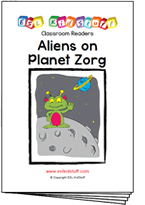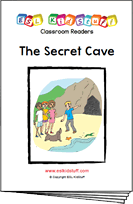Subject pronouns (I, you, he, she, we, they) lesson plan
Stand-alone lesson ESL kids lesson plan
Lesson plans for ESL kids teachers
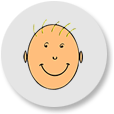
Subject pronouns (I, you, he, she, we, they)
In this lesson students learn the structure of subject pronouns plus “to be” in combination with adjectives and nouns. Students play fun games and activities, learn a new song and do a pronouns worksheet.
Members get accompanying flashcards, worksheets, song and classroom reader.
Download materials:
Our lesson plans are FREE!
Sign up for accompanying:
✔ worksheets
✔ homework sheets
✔ craft sheets
✔ flashcards
✔ song downloads & videos
✔ classroom readers & videos
Click to see lesson details, materials and supplies
Time: 40 mins – 1 hour
Objectives: Using subject pronouns to practice saying how different people are feeling or acting.
Structures: “Who is …?”, “I am”, “you are”, “he is”, “she is”, “we are”, “they are”, “who is”, “I/you/we/they like …”, “he / she likes …”.
Target vocabulary: today, happy, sad, hungry, quiet, noisy, sleepy.
Lesson materials
Flashcards:
- happy, sad, hungry, quiet, noisy, sleepy + various adjective, animal and transport flashcards
Printables:
- Subject pronouns 1 worksheet
- Subject pronouns 2 worksheet
- Who is happy? song poster
- Reader worksheet
Songs:
- Who is happy?
Readers:
- Aliens on planet Zorg
Additional materials:
- I, you, he, she, we, they vocab crossword
- I, you, he, she, we, they vocab word search
- Mary’s family worksheet
Supplies:
- [hide_on_uk]colored[/hide_on_uk][hide_on_us]coloured[/hide_on_us] pencils
- 6 large cards each with a subject pronoun written on (I, you, he, she, we, they) in thick marker pen
- empty plastic bottle
- Blu-Tack or tape to stick cards to your board and walls
- board with marker / chalk
- device to play the song on
This lesson is great for teaching the structure of subject pronouns plus “to be” in combination with adjectives and nouns.
Lesson procedure:
Warm up and maintenance:
The beginning of your lesson is extremely important: this is where you set the tone of your lesson and get everyone in the right frame of mind for learning English. It is also an opportunity to check homework and review previous lessons.
Click for warm up suggestions for the start of your lessons
These activities can be done in the following order at the start of your lesson:

1. Greetings and name tags
Greet the students by name as they enter the classroom and gesture for them to sit down. Before class prepare some blank name tags (stickers or pin-on tags). Give these out and have everyone write their names and put their tags on. If you use pin-on tags, you can keep and give out every class.

2. Homework check
Check each student’s homework set in the last lesson. Ask each student some questions about their homework worksheet (e.g. “what [hide_on_uk]color[/hide_on_uk][hide_on_us]colour[/hide_on_us] is it?”), give lots of praise, and then put some kind of mark on the homework sheet (e.g. a sticker, a stamp or draw a smiley face). Finally, tell your students to put their homework back into their bags.
3. Review past lessons
Reviewing past lessons is very important – students need constant practice of new vocab, structures, songs, games and so on. Always review parts of your last lesson as well as some parts from other previous lessons. You can spend 5-10 minutes reviewing – it’s fine to recycle games and activities from your past lessons to review as kids enjoy playing familiar games (although be careful not to play a game to death!). See the section “Other ideas to include in your warm” below for ideas.
You can also include review activities in the main body of your lesson. Kids can have short attention spans so it’s good to be able to pull out lots of activities during different stages of the lesson.
Other ideas to include in your warm up:
Ball pass questions
This is good to review questions from previous lessons. Get everybody standing in a circle.
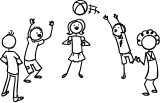
Round 1:
Take a ball and hold it and say, “My name is (you name)”. Then throw the ball to one student and say, “What’s your name?”. Students throw the ball around randomly, saying their names and asking for names.
Round 2:
This time ask a review question, e.g. “How many tables are there?”. Then throw the ball to a student who should answer, “There are (6) tables”. Help if necessary. Then that student throws the ball to another student and asks a “How many …?” question. Continue so everyone has a go. You can have multiple rounds with different topic questions.

Play “Spin the bottle”
Sit students in a circle with a bottle in the middle. Teacher spins the bottle. When it stops spinning the student it is pointing to has to answer a question. If the answer is correct then that student can spin the bottle. This is a good class warm up activity (e.g. How are you? What’s your [hide_on_uk]favorite[/hide_on_uk][hide_on_us]favourite[/hide_on_us] food? How’s the weather today?, etc.

Play “Vocabulary basketball”
This is a fun game which reviews vocabulary from previous lessons. You will need a basket (a trash can) and 2 balls (or 2 pieces of A4 paper scrunched up into balls).
Form 2 teams and line them up so that two players from each team are facing the front with the basket in front of them. Let both players throw their ball – if they get their ball into the basket they can try and win a point by giving the correct answer to a question the teacher asks. This can be an actual question (e.g. What are you wearing?) or a flashcard (What’s this?). Then they go to the back of the line. At the end, the team with the most points is the winner!
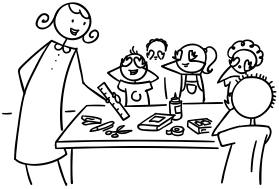
Play “What’s missing?”
This is a fun review memory game – students will have to try to remember review objects from previous lessons (e.g. classroom stationery). Lay the objects out on a table for all to see. Allow the students a minute to memorize the positions of the objects. Remove an object and hold it behind your back. Say, “Open your eyes!” – the first student who can shout out the missing object wins a point for his/her team. Play for all the objects.
Finally, calculate which team has won the most points and give them a round of applause.

Play “Quiz game show”
This is a fun quiz game, like a simple version of a TV game show. Draw some circles on the board and randomly write numbers 1, 2 or 3 in each circle. These will be points.
Put students into teams. Then ask the first team to choose a number – 1 is an easy question (e.g. “Do you like bananas?”) and 3 is a difficult question (e.g. point at a clock and ask, “What time is it?”). 2 will be in between in terms of difficulty. When the question has been answered correctly, erase that number circle. Play until all the number circles are gone – the team with the most points is the winner!

Read a classroom reader again
As you progress through the lessons you will start to build up a catalog of classroom readers (see our Readers download page at https://www.eslkidstuff.com). Kids love going back to old stories and reading through them again. Invite a student to pick a classroom reader and read through it as a class. Make the story as interactive as possible by asking questions (e.g. what [hide_on_uk]colors[/hide_on_uk][hide_on_us]colours[/hide_on_us] there are, the names of different objects, etc.) and getting students to speculate what is going to happen next in the story.

Talk about the weather (do after you have taught the weather lesson plan).
- Prepare a weather board. Before the first class prepare a piece of cardboard and cover it with felt – you are going to pin this to the wall. If you can, try and get blue felt (to represent the sky). Write at the top in large letters, “How’s the weather today?”. Below that write “Today it’s”. Cut out weather pictures (such as our weather flashcards) and stick some velcro on the back. Arrange the weather pictures around the edge of the board and then put the board on the wall of your classroom. You can now use this weather board at the beginning of every lesson.
- Ask about the weather. Ask, “How’s the weather today?” and have students put up their hands. Allow one weather condition per student (e.g. “It’s rainy”) and have each student come up and put a weather picture on the weather board.
- Introduce more weather vocabulary. Depending on weather conditions, you can introduce more weather words (with pictures … you can get students to draw them), such as:
- stormy
- misty
- showery
- freezing
- humid
- frosty
- icy
- drizzly
New learning and practice:
1. Introduce the vocabulary: subject pronouns (I, you, he, she, we, they)
Before class, prepare 6 large pieces of card with one subject pronoun written on each piece (I, you, he, she, we, they).

Get everyone standing up and show the first card “I”. Say, “I” and point to yourself and get everyone to do the same (pointing to themselves). Do a few times and then put the card on the board.
Next show the “you” card and point to someone and say, “you”, again have everyone follow along. For “he” and “she”, point at a girl and boy – check that everyone understands the difference. For “we”, grab a couple of students in a group hug and say, “we” and have everyone get into groups as they do this. Finally, for “they”, point at other students whilst saying, “they” and get everyone to do the same.

Now you will have all of the subject pronouns on the board. You are going to touch each card and get everyone to point and say the word – start slowly (“I” and point to yourself, “you” and point at someone else, etc.) and go through the pronouns going faster and faster. This is great fun and very confusing when it really speeds up.
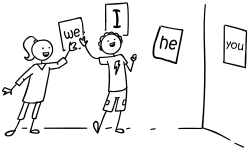
2. Play “Wall touch”
Next, stick the pronoun cards (that are on the board) around the walls of the classroom. Try and space them evenly around the room. Have everyone stand in the middle of the classroom. Shout out a pronoun (e.g. “we”) and everyone must rush to the correct word on the wall and touch it. Do this for all of the pronouns.
3. Do the “Subject pronoun chant”
Put the pronoun cards on the board in the correct order (I, you, he, she, we, they). Have everyone sit down and start clapping a rhythm along with you – clap hands together then slap legs, clap hands, slap legs, clap hands, slap legs, etc. (start off quite slow, all in time together). Once everyone is in time start the chant:
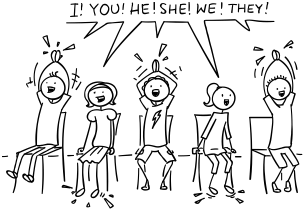
Teacher (chanting): I
Students (echoing): I
Teacher (chanting): you
Students (echoing): you
Teacher (chanting): he
etc.
… with the word on each hand clap (no chant on the leg slap yet).
Keep going and after a while add the verb to the leg slap:
Teacher (chanting): I – am
Students (echoing): I – am
Teacher (chanting): you – are
Students (echoing): you – are
Teacher (chanting): he – is
etc.
You can have some fun by going fast and slow, adjusting the pace.
4. Introduce the vocabulary: adjectives
Before class, print off some adjective flashcards, including the following: happy, sad, hungry, quiet, noisy, sleepy. Show the first flashcard (e.g. “happy”) and get everyone to do the action for the card (e.g. a big smile and exaggerate this by placing your hands in a smile shape to extend your own mouth (thumbs touching the corners of your mouth)). Then chorus the word 3 times. Go through each of the flashcards doing the actions and chorusing the words.
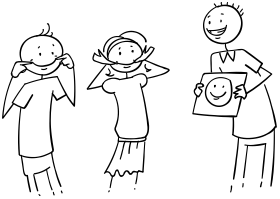

5. Play “Guess which adjective”
Have one student come to the front of the class and show him/her one of the adjective flashcards. He/She must do the action for that card – the first student to put his/her hand up and say the word correctly can act out the next flashcard adjective.
Keep going until everyone has had a chance to act out the adjective.
6. Sing the “Who is happy?” song
Put the subject pronoun cards on the board in the correct order as well as the adjective flashcards. Alternatively, use the “Who is happy?” song poster. Get everyone to stand up and follow you doing the actions and singing (as described in Gestures below). Play the song through 2 or 3 times.
Lyrics for “Who is happy?”
Verse 1:
Who is happy? Who is happy?
Who is happy today?
I am happy, I am happy,
You are happy, You are happy,
He is happy, He is happy,
She is happy, She is happy,
We are happy, We are happy,
They are happy, They are happy.
Verse 2:
Who is hungry? Who is hungry?
Who is hungry today?
I am hungry, I am hungry,
You are hungry, You are hungry,
He is hungry, He is hungry,
She is hungry, She is hungry,
We are hungry, We are hungry,
They are hungry, They are hungry.
Verse 3:
Who is quiet? Who is quiet?
Who is quiet today?
I am quiet, I am quiet,
You are quiet, You are quiet,
He is quiet, He is quiet,
She is quiet, She is quiet,
We are quiet, We are quiet,
They are quiet, They are quiet.
Verse 4:
Who is noisy? Who is noisy?
Who is noisy today?
I am noisy, I am noisy,
You are noisy, You are noisy,
He is noisy, He is noisy,
She is noisy, She is noisy,
We are noisy, We are noisy,
They are noisy, They are noisy.
Gestures for “Who is happy?”
The main learning point for this song is learning the subject pronouns, so the gestures will focus on these words:
– during the question part of each verse, do gestures for the adjectives:
- “Who is happy?” – do a big smile and exaggerate this by placing your hands in a smile shape to extend your own mouth (thumbs touching the corners of your mouth)
- “Who is hungry?” – look hungry and rub your tummy
- “Who is quiet?” – sing quietly and put your finger to your mouth in the “hush” gesture
- “Who is noisy?” – sing loudly and put arms out as if trying to be really noisy
– during the pronouns part of the song have everyone point for each line:
- “I am …” – point to yourself
- “You are …” – point to your partner
- “*He is …” – point to a boy in the class
- “*She is …” – point to a girl in the class
- “We are …” – put your arms out with hands bending inwards in the “group hug” gesture
- “They are …” – point around the classroom to different students with both hands
*In classes with only boys/girls use a photo on the wall to point at.

[hide_on_uk]Short sample (members get full-length song):
[/hide_on_uk]
[hide_on_us]Short sample (members get full-length song):
[/hide_on_us]
7. Read classroom reader “Aliens on planet Zorg”
This story will tie everything together – you can practice using the adjectives and subject pronouns from the song. Before class, download and print off the reader “Aliens on planet Zorg”. As you go through each page, point to the pictures and try to elicit the adjective and subject pronoun for the aliens, for example:
Teacher: (pointing at the aliens on page 3) What [hide_on_uk]color[/hide_on_uk][hide_on_us]colour[/hide_on_us] are these aliens?
Students: Purple!
Teacher: Yes, that’s right! And what are the purple aliens doing?
Students: Eating rocks!
Teacher: Exactly! Why are they eating rocks? Are they full up?
Students: No, they are hungry!
Teacher: Yes, they must be hungry if they are eating rocks! Let’s check ..
(reading from page 3) .. “Look! These aliens are called Zillions. They are always hungry!”
etc.
Get the students really involved in the reader by asking lots of questions (e.g. eliciting [hide_on_uk]colors[/hide_on_uk][hide_on_us]colours[/hide_on_us], what they are doing, etc.). Page 7 is particularly interactive as the alien asks your students direct questions – get everyone to say if the statements are true about them, for example:
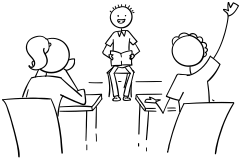
Teacher: (reading from page 7) “How about you? Which of these are true about you?”. Ok, the first one says “You are happy”. Is that true about you Tom?
Student: Yes, I am happy!
Teacher: Good, how about you, Matilda? Are you happy?
Student: No.
Teacher: No? You are not happy? Why not?
Student: I’m hungry!
Teacher: Hungry! Yes, me too! It’s nearly lunch time! etc.
After reading the story, give out a reader worksheet to each student and have everyone complete the sentences. Then go through the answers as a class.
Alternatively, watch our video version of the reader (Internet connection required).
8. Play the “I like strawberries” pair-work activity
In this game students are going to practice using subject pronouns to talk about food likes. Clean your board and write “Food” at the top. Draw a picture of a strawberry and say, “I like strawberries – yummy!” (and rub your tummy). Get students, one-by-one to come to the board and draw a food they really like – each time make sure everyone knows who likes what. It is fine if some students draw the same thing – in fact this will help to practice the words “we” and “they”.

Once all of the food pictures are on the board, model the activity with one student. Stand together in front of the board and choose a food picture. Point at the person who drew it and say (for example), “He likes hot dogs”. Do the same for some more food pictures – say “she likes ~” for a girl’s picture, “I like~” for your picture, “you like~” for your partner’s picture, “we like~” for any people who have drawn the same picture as you and “they like~” for others who have drawn the same picture. Each time students take turns to say a sentence.
Now put the class into pairs and have them say sentences together about different student’s food likes in the classroom, all the time pointing and using a pronoun. After about 5 minutes end the activity and then ask some pairs to stand up and demonstrate to everyone some of the sentences they said.
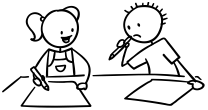
9. Do “Subject pronouns 2” worksheet
Sit everyone down at their desks and give out the worksheets. Have the students complete the sentences. As they are working, circulate and ask questions (e.g. What food does she like?).
10. Play “Spin the bottle”
We’ll end with a fun game which practices the subject pronouns and “to be”. Before class, prepare a bunch of flashcards – some adjectives (e.g. angry, fast, hungry, etc.) some animals (e.g. elephant, lion, rabbit) and some transport (e.g. car, airplane, train) – shuffle them well. You’ll also need a plastic bottle.

Get everyone to sit on the floor in a circle with the bottle and the stack of flashcards (face-down) in the middle (large classes can be split into a few circles). Teacher starts by spinning the bottle – when the bottle stops spinning the teacher has to pick up a flashcard and make a sentence using a pronoun depending on who the bottle is pointing at. For example, if the bottle is pointing at a girl and the flashcard is “hungry” say “She is hungry” and point at the girl. The girl then has to do the action (act hungry and rub her tummy). Other examples are:
- bottle pointing at a boy / elephant flashcard – “He is an elephant” (the boy acts as an elephant)
- bottle pointing at a girl / train flashcard – “She is a train” (the girl pretends to be a train and choo-choos around the classroom)
- bottle pointing the person who span it / cat flashcard – “I am a cat” (the spinner acts as a cat)
- bottle pointing between 2 people / sleepy flashcard – “They are sleepy” (the two students yawn and fall asleep)
- bottle pointing between the spinner and another student / airplane flashcard – “We are airplanes!” (both students fly around the room like airplanes)
Then, the person who had to do the action can spin the bottle. This game is great fun – you can play it for quite a while as it creates a lot of laughter but also is a great way to practice the target structures.
Wrap up:
Assign homework: “Subject pronouns 1” worksheet
Click for wrap up suggestions for the end of your lessons

1. Assign homework
Each week give out a homework worksheet for your students to take home. Hold up the homework worksheet and model how to do it. Give out the worksheets and say, “Put your homework in your bags”.

2. Do “Quick check”
Time to leave the class. Make sure everything is put away and the students have gathered their belongings. Have them line up at the door and place yourself between the door and the students. For each student check one new word or phrase, for example:
- hold up an object or flashcard (such as an item of clothing) and ask, “What’s this?”
- ask a question from the lesson (e.g. “Where do you live?”, “Do you like bananas?”, “Can you play chess?”, etc.)
When they give you the correct answer say goodbye and let them leave. If their answer is wrong, have them go back to the end of the line – they will have to try again once they reach the front!
Other lesson plans
Actions, verbs & tenses:
- Can – for ability
- Morning routines
- Daily routines & times of the day
- Actions – Present continuous
- Future plans using “going to”
- Past tense activities – Regular verbs
- Past tense activities – Irregular verbs: Part 1
- Past tense activities – Irregular verbs: Part 2
Adjectives:
- Describing people
- Describing things
- Comparing things (Comparative adjectives)
- Comparing things (Superlative adjectives)
Adverbs:
Alphabet:
Animals:
Body:
Classroom:
Clothes:
Colors:
Colours:
Directions:
Family:
Feelings & emotions:
Food:
Health & sickness:
Holidays & festivals:
Jobs:
Likes, dislikes & favorites:
Likes, dislikes & favourites:
- Likes & dislikes
- [hide_on_uk]Favorites[/hide_on_uk][hide_on_us]Favourites[/hide_on_us] and asking why
Nature & Our world:
Numbers:
Places & where we live:
Prepositions of location:
Pronouns:
Shapes:
Shopping:
Sports:
Time, days, months, seasons:
Toys:
Transport & travel:
Weather:


